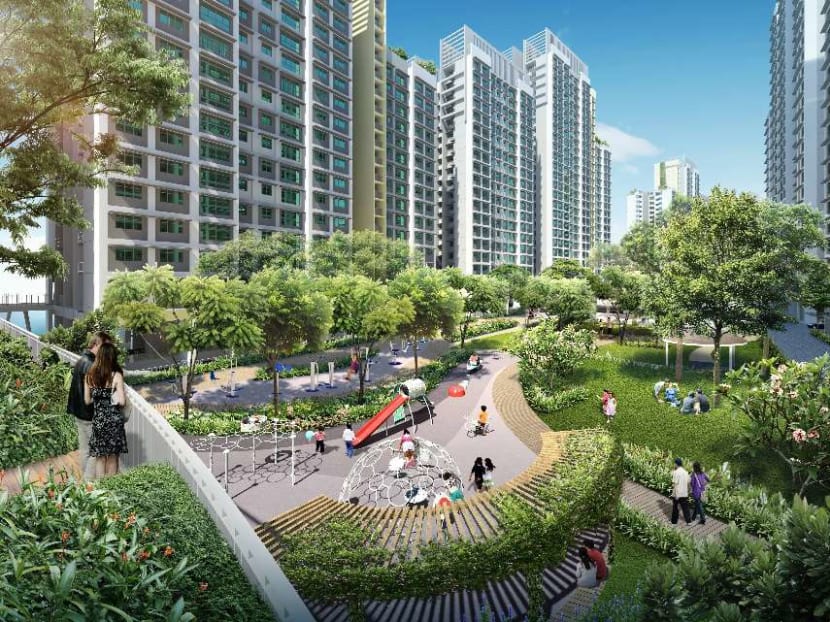Future HDB estates to be ‘nature-centric’
SINGAPORE — Residents of new Housing and Development Board (HDB) flats – starting with Punggol Northshore District – will get to go home to “nature-centric neighbourhoods” that include features such as dragonfly ponds, bird sanctuaries and butterfly gardens.

Residents of new Housing and Development Board (HDB) flats will get to go home to “nature-centric neighbourhoods” that includes features such as dragonfly ponds, bird sanctuaries and butterfly gardens.
SINGAPORE — Residents of new Housing and Development Board (HDB) flats – starting with Punggol Northshore District – will get to go home to “nature-centric neighbourhoods” that include features such as dragonfly ponds, bird sanctuaries and butterfly gardens.
While green spaces have been part of public housing in recent years, this is the first time the HDB is creating a landscapes in a “holistic manner” as part of the Biophilic Town Framework that outlines strategies needed to plan and design urban landscapes.
And having refined and validated the framework over three-and-a-half years through a research collaboration with the National University of Singapore (NUS), the Urban Redevelopment Authority (URA), and National Parks Board (NParks), it is now ready for implementation in new HDB projects.
The first estate to experience these nature-centric landscapes is Punggol Northshore District, which comprises about 5,700 flats that will be completed progressively from 2020.
Other HDB projects that will also be adopting the Biophilic Town Framework are Woodleigh Glen and Woodleigh Hillside in Bidadari Estate.
Designing the environment under this framework takes into consideration five key elements - soil, flora and fauna, outdoor comfort, water and people. Architects assess how these elements can be incorporated into the neighbourhood landscape from the outset, and put forth an optimal design that harmonises the habitat and its inhabitants.
For instance, with Singapore’s hot and humid weather, footpaths are placed along key wind channels to offer a pleasant walk, while playgrounds and garden trails where residents linger are shielded from direct sunlight and glare. With such designs, HDB aims to encourage residents to immerse in nature and mingle with their neighbours.
Vegetation in Punggol Northshore will also be specially selected for their effectiveness in sequestering excess carbon and removing air pollutants from the environment. For example, Mimusops elengi (Tanjong Tree) will be planted at the end of the wind corridors as they are effective in removing air pollutants and enhancing the overall air quality, while Filicium decipiens (Fern Tree) is effective in sequestering excess carbon from the environment.
In addition, stormwater management measures will also be deployed to achieve good water quality. A district-wide network of vegetated bioswales and rain gardens were incorporated into the designs to filter out sediments and treat the rainwater runoff naturally.
To offer a multisensory experience and promote residents’ well-being, ecological ponds such as dragonfly ponds will be introduced to encourage residents to draw closer to nature. As dragonflies are predators, it would also be useful in controlling mosquito breeding.
Although these new features under the Biophilic Town Framework will be taken into consideration in its pricing, HDB told TODAY it is “not expected” to have a “significant impact” on the pricing.
This is because pricing of HDB flats takes into account several other factors such as the prevailing market conditions at the time of offer, location, amenities, lease period, ownership restrictions, design features and unique attributes, HDB said.
HDB’s Chief Executive Officer, Dr Cheong Koon Hean said: “The Biophilic Town Framework, which we have developed, provides a strong foundation for holistic planning and design of neighbourhood landscapes, so that our residents can enjoy a strong sense of place and well-being.”
“From this month, the framework will be progressively applied to new housing projects. This marks a new milestone in our journey towards well-designed, sustainable and community-centric towns under our Roadmap to Better Living in HDB Towns.”









